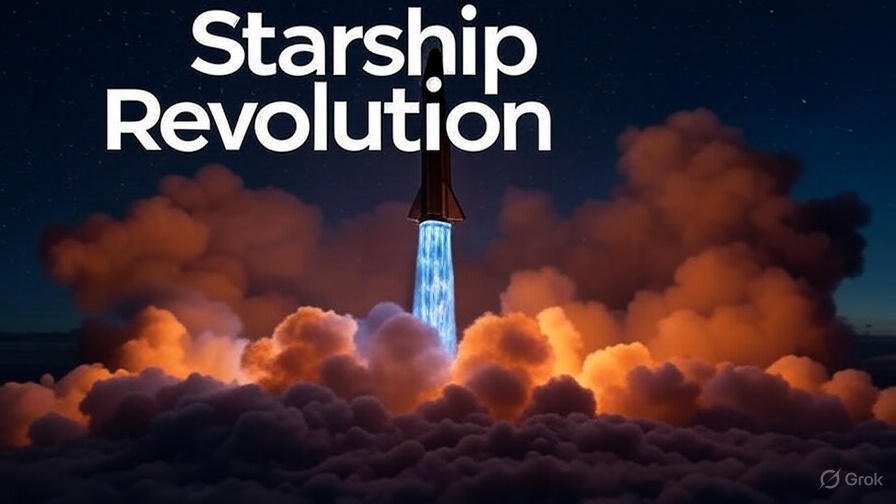SpaceX Starship's Epic 10th Launch: What It Means for the Future of Space Travel

Picture this: a towering rocket, taller than a 40-story building, roaring into the sky from a dusty Texas launchpad, carrying humanity’s dreams of Mars and beyond. That was the scene on August 26, 2025, when SpaceX’s Starship nailed its SpaceX Starship 10th launch. This wasn’t just another test flight—it was a game-changer for reusable rockets 2025 and a big step toward Mars missions 2025. With a splashdown in the Indian Ocean and some slick satellite deployments, the launch showed what Starship can do, even if it hit a few bumps along the way. Folks online are buzzing about it, with some calling it a “cosmic milestone,” while others point out the challenges still ahead. Let’s unpack the highs and lows of this epic launch and what it means for SpaceX future space travel.
Why the 10th Launch Matters
The SpaceX Starship 10th launch wasn’t just a test—it was a bold statement. Starship, the biggest rocket ever built, stands 403 feet tall and packs a punch with its Super Heavy booster and 33 Raptor engines. Launched from Starbase, Texas, this flight came after three fiery flops earlier in 2025, making it a make-or-break moment for SpaceX. It’s all about proving Starship can handle big jobs, like landing astronauts on the Moon for NASA’s Artemis III or carrying settlers to Mars someday. Web sources say this launch was about testing satellite deployment and surviving the brutal heat of reentry—both critical for making space travel cheaper and more routine.
The buzz on X is electric, with people sharing clips of the launch and calling it a “giant leap” toward living on Mars. But not everyone’s sold—some are skeptical about hitting deadlines, especially with Elon Musk’s ambitious talk. This launch is a big deal because it shows SpaceX’s grit, learning from crashes to build something that could change how we explore the cosmos.
What Went Right: Launch Wins
The Starship launch successes had everyone cheering. Here’s what SpaceX pulled off:
- Smooth Splashdown: The Starship upper stage landed softly in the Indian Ocean, holding up against reentry heat that wrecked earlier models. New heat shield tiles made the difference, a huge win for reusable rockets 2025.
- Satellite Drop: It deployed eight dummy Starlink satellites using a clever Pez dispenser-like system, proving it can carry and release payloads like a pro.
- Booster Power: The Super Heavy booster, with 33 engines, pulled off a simulated soft landing in the Gulf of Mexico. Only one engine conked out, and the rest kept the show going strong.
NASA folks chimed in on X, saying this gets us closer to landing on the Moon again. Web sources confirm the mission hit all its main goals, boosting confidence after earlier explosions. The splashdown alone had people on X calling it “picture-perfect,” and it’s a big deal for cutting launch costs—potentially down to a few million bucks per trip, compared to tens of millions for older rockets.
Bumps in the Road: Launch Challenges
Even with all the wins, the Starship launch challenges remind us this isn’t easy. Here’s what went wrong:
- Engine Glitch: One of the 33 Raptor engines shut down mid-flight, though the others picked up the slack. Web sources say engine reliability is still a work in progress.
- Reentry Wear: The upper stage’s rear flaps took some heat damage, showing the heat shield needs more tweaking to be fully reusable.
- Launch Scrubs: The team had to delay twice—once on August 24 for a liquid oxygen leak and again on August 25 due to stormy weather, proving launches are a logistical beast.
On X, some folks are worried these hiccups could push back NASA’s Moon plans or Musk’s Mars dreams, with posts asking if 2026 for Mars is “way too optimistic.” Web sources point out that SpaceX still needs to nail in-orbit refueling, a huge unsolved puzzle for deep-space trips. These challenges show Starship’s not quite ready to fly on autopilot, but SpaceX’s knack for fixing problems keeps hope alive.
Revolutionizing Reusable Rockets
The real magic of the SpaceX Starship 10th launch is how it’s pushing reusable rockets 2025 to new heights. Starship’s designed to be fully reusable—both the booster and the upper stage—which could make space travel as routine as catching a flight to New York. Web sources say SpaceX’s earlier success in catching the Super Heavy booster with giant “chopstick” arms on the launch tower (back in the fifth flight) is a blueprint for quick turnarounds. Imagine rockets launching and landing like planes, ready to go again in hours!
This launch didn’t try a tower catch but focused on in-flight tests that gave SpaceX tons of data to make reusability better. They’re getting closer to Musk’s wild dream of 24 launches in 24 hours. On X, people are geeking out over the engineering, with one user calling it “mind-blowing,” but others say full reusability is still a “tough nut to crack.” Web sources agree, noting five successful flights out of ten since 2023 show progress, but perfection’s still a ways off.
Stepping Closer to Mars
The SpaceX Starship 10th launch is a big leap toward Mars missions 2025. Elon Musk’s got his eyes on a Martian colony, and Starship’s the key to making it happen. It’s built to haul massive payloads—think entire habitats—and carry crews to the Red Planet. Web sources say SpaceX plans to send five uncrewed Starships to Mars in 2026 to test landings, with crewed trips eyed for 2030. Musk’s even tossed out a 50/50 shot at hitting 2026 for humans, which has X buzzing with both excitement and doubt.
The splashdown and satellite deployment proved Starship can handle the tough stuff, like surviving reentry and delivering cargo. But there’s a catch: in-orbit refueling, which needs 10–20 tanker flights per mission, hasn’t been tested yet, according to web sources. On X, people are dreaming of “Martian cities,” but some are skeptical, pointing out life-support systems and radiation protection are still big hurdles. Still, this launch keeps the Mars dream alive.
Inspiring the Next Generation
The SpaceX Starship 10th launch isn’t just about rockets—it’s firing up kids across the US to dream big. Schools, especially in places like Houston, are using SpaceX’s open data to teach rocket science, turning math and physics into real-world adventures. Web sources say districts are weaving Starship’s story into STEM lessons, showing students how engineering can take us to Mars. On X, teachers are sharing how kids are “obsessed” with the launch, sketching rockets and talking about space careers.
These programs, backed by NASA’s STEM push, are planting seeds for future climate tech jobs and space roles. But there’s a gap—some schools don’t have the tech or funding to join in, echoing equity issues seen in AI education tools. Still, the launch’s impact is undeniable, sparking a passion for SpaceX future space travel in young minds.
What’s Still Ahead: The Big Challenges
The Starship launch challenges show there’s work to do. Web sources point out that building a heat shield that’s reusable right after landing is a beast—NASA’s old Space Shuttle needed months to fix up. The single engine shutdown is a reminder that Raptor engines need to be rock-solid. Plus, in-orbit refueling is a billion-dollar puzzle SpaceX hasn’t solved yet, and it’s make-or-break for Mars.
On X, some worry NASA’s 2027 Moon landing might slip to 2028 if these issues linger, and the FAA’s environmental reviews could slow things down too. Web sources mention SpaceX needs to ramp up testing to hit its goal of 25 launches in 2025. These hurdles are steep, but SpaceX’s track record of turning failures into wins keeps the dreamers hopeful.
Shaping the Future of Space Travel
The SpaceX Starship 10th launch is setting the stage for a space travel revolution:
- Cheaper Launches: Fully reusable rockets could drop costs to a couple million bucks per flight, compared to $67 million for Falcon 9, opening the door to more missions.
- Mars Dreams: Successes like this make 2026 uncrewed Mars trips possible, inching us toward Musk’s vision of a Martian colony.
- Space for All: Starship’s massive payload capacity could boost Starlink’s internet coverage, making space tech part of daily life.
Web sources say SpaceX is planning 25 launches in 2025, aiming to catch both the booster and upper stage with the tower. On X, folks are calling it a “space game-changer,” though some warn past crashes mean we’re not there yet. The road’s long, but this launch proves we’re getting closer.
Wrapping It Up: A Cosmic Leap
The SpaceX Starship 10th launch on August 26, 2025, was a wild ride, with jaw-dropping Starship launch successes like a perfect splashdown and satellite drop, even if Starship launch challenges like engine glitches showed there’s work left. It’s a massive step for reusable rockets 2025 and Mars missions 2025, making SpaceX future space travel feel closer than ever. From inspiring kids in classrooms to paving the way for lunar landings, this launch is rewriting what’s possible. Got thoughts on Starship’s journey? Drop them below and check out more space stories on Mehena to keep up with this cosmic adventure!





